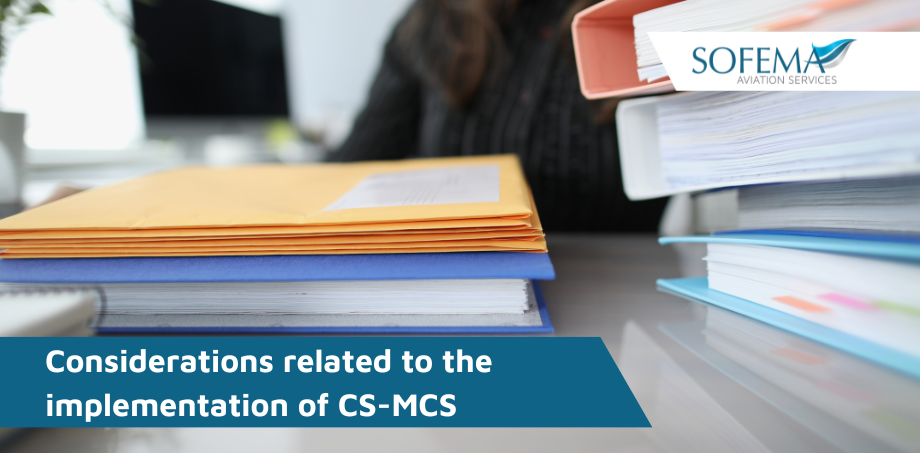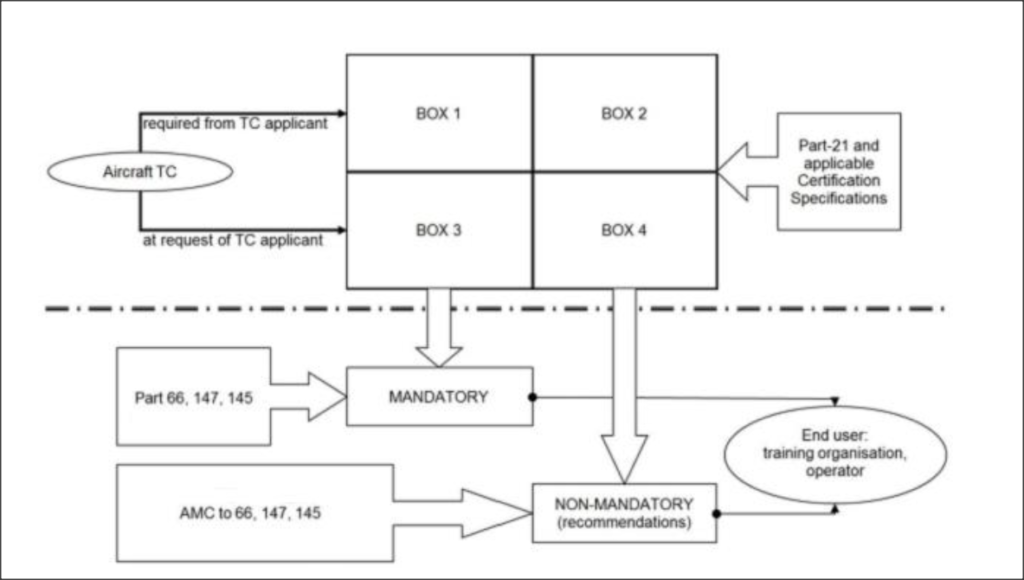Sofema Aviation Services (SAS) www.sassofia.com considers the process whereby Certification Specification Maintenance Certifying Staff (CS-MCS) is derived from source data.
Introduction Concerning the Obligations for a TCH to provide the OSD-MCS:
The introduction of the OSD in the Basic Regulation created the obligation for the Type Certificate Holder to provide the “minimum syllabus” for maintenance certifying staff for certain aircraft.
As a consequence of this, Appendix III to Part-66 (in its point 1(a)(ii)) was amended with Regulation (EU) 1321/2014 to state that the theoretical training and examination shall comply with:
- “the relevant elements defined in the mandatory part of the operational suitability data established in accordance with Regulation (EU) No 748/2012 or, if such elements are not available, the standard described in point 3.1 of this Appendix”
Affected Aircraft (Art. 1 37a1)
- Only new TCs, and applications filed after 17 February 2014
- Limited to Group 1 a/c. GM No.1 to 21.A.15d
- OSD approval to be obtained before EIS of the first a/c by an EU operator or need to use OSD for preparation of such EIS. GM to 21.A.21f
Note: [Art. 1 37a2] Catch-up for existing TC or ongoing certifications, for which the application was filed before 17 February 2014, is voluntary.
Additional Notes
- [Art. 1 37a3] No OEB-MCS-approved report exists: therefore, no Grandfathering activity is expected.
- [Art. 1 37a4] DOA scope extension before 18 December 2015. If no OSD-MCS exists, no extension is required.
- [Art. 2] Changes and STCs are exempted until 19 Dec.2016. If no OSD-MCS exists, no application for OSD-MCS change is required.
- Memorandum CM-MCSD-001 provides specific guidance in the preparation of the Special Condition (SC) as per Part 21.A.16B which will be included in the OSD certification basis to address the MCSD.
- The SC is conveyed through a Certification Review Item (CRI A-MCSD).
Training Organisation Requirements Art. 6.3
Type training courses approved before the approval of the OSD-MCS shall include the relevant elements defined in the mandatory part of that OSD latest between:
- 18 December 2017 or
- Within two years after the OSD approval.
Process of Delivery
The type rating proposed by the TC Applicant / TC Holder and evaluated by the Agency is the type rating for the purpose of Aircraft Maintenance License (AML) endorsement. Based on a favourable conclusion of the evaluation, this type rating will be included in the Type Certificate Data Sheet (TCDS).
The type rating(s) determined should address all (new) models/variants specified in the TCDS.
For the purpose of this certification memorandum, the following criteria should be evaluated to require a different maintenance type rating separate from the existing type ratings:
- The aircraft is subject to a different aircraft type certificate; or
- The aircraft is subject to a major modification for installation of another type of engine; or
- The aircraft is subject to a STC for installation of another type of engine; or
- The analysis on the minimum syllabus content and/or training duration results in an evident and substantial difference; or
- Such a recommendation is made by the Applicant or the Agency.
Developing the Minimum Syllabus Content
The minimum syllabus content specified for the type should be clearly identified and allocated to one of the four “box” categories identified in GM No 3 to 21.A.15(d) (see fig. 1) in order to identify its mandatory or non-mandatory status. The contents should address the minimum theoretical and practical type training for Maintenance Certifying Staff.
Whilst the TC Applicant/Holder should be adequately supporting each proposed element and its “box” categorisation, a list of expected content elements is provided below. The Applicant should consider these examples as being neither limiting nor exhaustive for their proposal.
Box 1 – Type rating determination
The base aircraft configuration relevant to maintenance type training and which should be addressed in accordance with the certificated type design.
This configuration should be detailed to the ATA system – subsystem level and include the categorisation of technical information to be addressed in training (e.g. location, description, indication, normal operation, abnormal operation, MMEL specific maintenance actions called in some MMEL items dispatch condition as maintenance procedure(s) (M)).
The list should be detailed to ATA component level in cases when the novelty or other characteristics of the component justify/require such a detail.
The certificated a/c configuration detailed in Box1 should cover the complete base aircraft configuration relevant to maintenance type rating training and should leave the certificated configuration options (i.e. options at system, subsystem or equipment/appliance level in addition to/in place of the base configuration) to be addressed in Boxes 3 and 4.
Maintenance Area of Special Emphasis
MASE – any element considered by the applicant as having a degree of novelty, specificity or uniqueness relevant to the maintenance of his product. This could be a technical or operational feature that maintenance personnel need to be aware of and take into consideration.
Box 2 – Student prerequisites (knowledge, experience, qualification) for the particular a/c type training (e.g. previous exposure to and type of a/c maintenance experience; a/c type maintenance related elements for composite repair and bonding and appropriate knowledge, experience, and awareness in accordance with AMC 20-29, SAE AIR 5719).
Box 3 – All elements which should be considered in addressing difference training between types or between models under the same type (as categorised in Appendix I to AMCs of Part-66). Those elements should be identified using the same criteria utilised for Box 1.
Box 4 – All and any elements identified by applying the Box 2 type of content rationale and which should be considered in addressing a difference training between types or models under the same type (as categorised in Appendix I to AMCs of Part-66).
- Course outline, which may include footprints, all learning objectives, examination elements or full developed course on request when available.
- Potential use of specific Maintenance Simulation Training Devices (MSTD) to be used in imparting some of the type training minimum syllabus elements;
- Type rating training course instructional duration (i.e. consolidated per the whole course and/or segregated per elements of the minimum syllabus);
Note: in the absence of any recommendation about the overall course length, the figures as mentioned in Part 66, Appendix III, 3.1 will apply. (Outlines of any other supplemental courses e.g. for engine run-up, advanced T/S, special complex composite repairs, specific basic knowledge training needed.)
Next Steps
Follow this link to our Library to find & Download related documents for Free.
Sofema Aviation Services (SAS) www.sassofia.com provides regulatory training for EASA Part 21, CS 25 & OSD – please see the following course. For additional questions or comments please visit our websites or email team@sassofia.com
Tags:
Aircraft Maintenance License, Aircraft Maintenance License (AML), aviation, CS-MCSD, Maintenance Area of Special Emphasis, Maintenance Certifying Staff, MASE, Operational Suitability Data (OSD), OSD, Regulation EU 1321/2014, SAS blogs, TCDS, TCH, Type Certificate, Type Certificate Data Sheet





